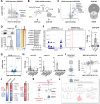A searchable atlas of pathogen-sensitive lncRNA networks in human macrophages
- PMID: 40399309
- PMCID: PMC12095776
- DOI: 10.1038/s41467-025-60084-x
A searchable atlas of pathogen-sensitive lncRNA networks in human macrophages
Abstract
Long noncoding RNAs (lncRNA) are crucial yet underexplored regulators of human immunity. Here we develop GRADR, a method integrating gradient profiling with RNA-binding proteome analysis, to map the protein interactomes of all expressed RNAs in a single experiment to study mechanisms of lncRNA-mediated regulation of human primary macrophages. Applying GRADR alongside CRISPR-multiomics, we reveal a network of NFκB-dependent lncRNAs, including LINC01215, AC022816.1 and ROCKI, which modulate distinct aspects of macrophage immunity, particularly through interactions with mRNA-processing factors, such as hnRNP proteins. We further uncover the function of ROCKI in repressing the messenger of the anti-inflammatory GATA2 transcription factor, thus promoting macrophage activation. Lastly, all data are consolidated in the SMyLR web interface, a searchable reference catalog for exploring lncRNA functions and pathway-dependencies in immune cells. Our results thus not only highlight the important functions of lncRNAs in immune regulation, but also provide a rich resource for lncRNA studies.
© 2025. The Author(s).
Conflict of interest statement
Competing interests: The authors declare no competing interests.
Figures






References
MeSH terms
Substances
Grants and funding
- LOEWE/2/13/519/03/06.001(0002)/74/Hessisches Ministerium für Wissenschaft und Kunst (Hessen State Ministry of Higher Education, Research and the Arts)
- LOEWE/5/A004/519/06/00.005(0008)/E31/Hessisches Ministerium für Wissenschaft und Kunst (Hessen State Ministry of Higher Education, Research and the Arts)
- LOEWE/2/13/519/03/06.001(0002)/74/Hessisches Ministerium für Wissenschaft und Kunst (Hessen State Ministry of Higher Education, Research and the Arts)
- 10.21.2.024MN/Fritz Thyssen Stiftung (Fritz Thyssen Foundation)
- SFB-TR-84 (subproject C10)/Deutsche Forschungsgemeinschaft (German Research Foundation)
- BA 2168/25-1/Deutsche Forschungsgemeinschaft (German Research Foundation)
- TRR 167/2 NeuroMac/Deutsche Forschungsgemeinschaft (German Research Foundation)
- CIBSS - EXC-2189 - Project ID 390939984/Deutsche Forschungsgemeinschaft (German Research Foundation)
- SFB-1213 (Project A01)/Deutsche Forschungsgemeinschaft (German Research Foundation)
- SFB-TR-84 (subproject C1)/Deutsche Forschungsgemeinschaft (German Research Foundation)
- PerMed-COPD (01EK2203A)/Bundesministerium für Bildung und Forschung (Federal Ministry of Education and Research)
- Deep Legion (031L0288A)/Bundesministerium für Bildung und Forschung (Federal Ministry of Education and Research)
LinkOut - more resources
Full Text Sources

